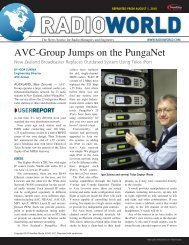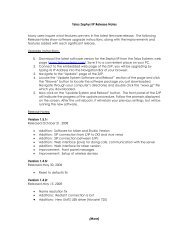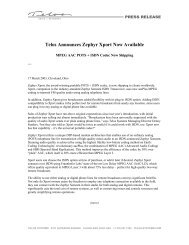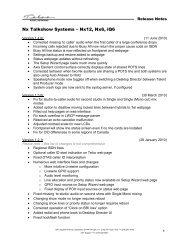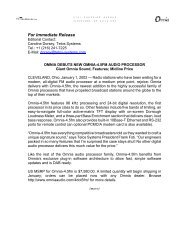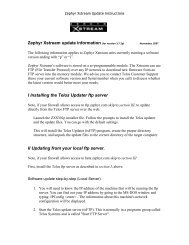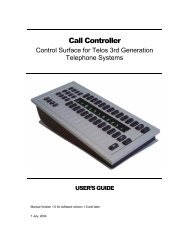NOW! 12-13 - Telos
NOW! 12-13 - Telos
NOW! 12-13 - Telos
You also want an ePaper? Increase the reach of your titles
YUMPU automatically turns print PDFs into web optimized ePapers that Google loves.
TECHTALK BLOG<br />
TELOSALLIANCE.COM/BLOG<br />
ii. When a signal exists in only one channel of a stereo-<br />
phonic sound transmission having more than one<br />
stereophonic subcarrier in the baseband, the modu-<br />
lation of the carrier by audio components within the<br />
audio baseband range of 23kHz to 99kHz shall not ex-<br />
ceed 53% with total modulation not to exceed 90%.<br />
The FM-Stereo system, as described above, has worked quite<br />
well for 50 years, but not without challenges. Most notable is<br />
multipath distortion, especially in areas of congested buildings,<br />
hills, and/or mountainous terrain. Also, radio broadcasters have<br />
added incremental signals within the multiplexed spectra. Radio<br />
Data Services (RBDS) based at 57kHz, as well as a 92kHz SCA can<br />
additionally occupy the signal. The modulation index of the FM<br />
carrier is further reduced with each and every added signal, thus<br />
increasing the sensitivity of multipath distortion in the receiver.<br />
Since the inception of stereophonic broadcasting, there has been<br />
no technical change to the infrastructure of the Zenith/GE sys-<br />
tem at all. The FCC rules are quite speciic regarding the multiplex<br />
spectrum, and its interoperability as a system. Considering the<br />
above mentioned challenges, and the alternatives a listener now<br />
has, it makes practical, as well as good business sense to inves-<br />
tigate improvements to the present system. It stands to reason<br />
that any means proposed must be backward compatible with ex-<br />
isting stereo receivers. After 50 years of marriage to FM, a silver<br />
anniversary present seems to be in order!<br />
TECHNICAL CHALLENGES FOR FM-STEREO<br />
Multipath is easily the largest annoyance to a radio listener. Broad-<br />
cast markets located in cities with many large downtown build-<br />
ings, and/or mountainous terrain, suffer even more on account of<br />
it. Increased multipath is a direct result of low modulation index<br />
within the FM carrier. As more spectra is utilized within the multi-<br />
plex signal, the index of the carrier is reduced. The following condi-<br />
tion creates maximum stress of the FM-Stereo system, and gener-<br />
ates the lowest modulation index: A single audio channel, either<br />
Left or Right only, utilizes the most amount of spectra within the<br />
system. By example, a 15kHz tone in the left channel only, will pro-<br />
duce multiplex spectra at 15kHz, 19kHz (stereo pilot tone), 23kHz,<br />
and 53kHz. Each of these signals will reduce the modulation index<br />
to its smallest level, which increases sensitivity to multipath in the<br />
receiver. Figure–1 is an illustration of this.<br />
Figure-1, 15kHz, Left channel only<br />
BROCHURES<br />
OMNIAAUDIO.COM/BROCHURES<br />
SOFTWARE UPDATES<br />
OMNIAAUDIO.COM/SOFTWARE<br />
Note the 30kHz difference in the L-R subcarrier of the two side-<br />
bands located at 23kHz and 53kHz. This is generated by the DS-<br />
BSC process of (38kHz – 15kHz) for the lower sideband at 23kHz,<br />
and (38kHz + 15kHz) for the upper sideband at 53kHz. During an<br />
instance of multipath, as the multiple relections of the FM car-<br />
rier arrive at, and then become demodulated in the receiver, the<br />
time delay difference created by the multiple carrier relections<br />
will offset the phase of the upper and lower sidebands. During<br />
the demodulation process and decoding, stereo separation at<br />
these frequencies is reduced, along with generated distortion, as<br />
the recovered L-R level is negatively altered due to phase shift<br />
brought on by multipath.<br />
Bandwidth of the conventional analog FM channel is allocated for<br />
99kHz of spectrum use. The FM-Stereo system requires 53kHz<br />
(0Hz – 53kHz) of this available real estate. The remaining 46kHz<br />
(53kHz – 99kHz) is used for RBDS and SCA services. Common<br />
practice requires the use of audio processing to insure proper<br />
peak level and bandwidth control of the various signals present<br />
in the multiplex spectrum. Current generation processors are ca-<br />
pable of creating near-theoretical multiplex signals. In these cas-<br />
es, there are little, if any, transmission dificulties for the signal.<br />
Some broadcasters choose to employ a form of processing<br />
known as composite clipping. This technique inserts a hard lim-<br />
iter (clipper) at the output of the stereo baseband generator,<br />
and will induce up to as much as 3dB of clipping to the multiplex<br />
signal. These devices provide no additional iltering to remove<br />
unwanted harmonic content from the clipping process. The ad-<br />
ditional harmonics will cover the entire 46kHz, and beyond, used<br />
for RBDS and SCA services. This creates interference and distor-<br />
tion to those signals. Also, these harmonics may interfere with<br />
the digital carriers generated for HD Radio, as these carriers are<br />
set <strong>12</strong>0kHz out from the main channel carrier.<br />
Alternate Approach: Single Sideband Suppressed Carrier (SSBSC)<br />
What if we were to take the FM multiplex signal that looks like the<br />
one in Figure-2 …and transmit it like the one in Figure-3.<br />
Figure-2<br />
FIND A DEALER<br />
OMNIAAUDIO.COM/BUY<br />
AUDIO PROCESSING | FM | FM+HD | AM | MULTICASTING | CODED AUDIO | STUDIO APPLICATIONS<br />
OMNIAAUDIO.COM<br />
53






